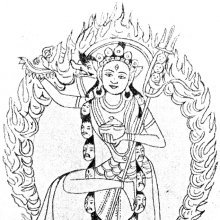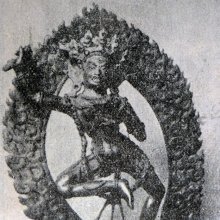Kapalasana, Kapālāsana, Kapala-asana: 1 definition
Introduction:
Kapalasana means something in Hinduism, Sanskrit. If you want to know the exact meaning, history, etymology or English translation of this term then check out the descriptions on this page. Add your comment or reference to a book if you want to contribute to this summary article.
Images (photo gallery)
In Hinduism
Yoga (school of philosophy)
Source: archive.org: Yoga Tradition of the Mysore PalaceKapālāsana (कपालासन) is a type of posture (āsana), according to verse 31 of the Śrītattvanidhi.—Accordingly, “Place the head on the ground. Raise the feet up. This is the head-stand, kapālāsana”.
The 19th-century Śrītattvanidhi is a sanskrit treatise describing 80 primary āsanas, or ‘posture’ (e.g., kapāla-āsana) and several additional ones.
The name kapālāsana is not found in Iyengar but kapālāsana means headstand. It is called śīrṣāsana in Iyengar. See narakāsana for further notes regarding this āsana. This āsana is considered to be almost the centre of pre-modem yoga representing the reversal of the body, the reversal of the body processes through the inversion. śirāsana is referred to in the Mallapurāṇa list.

Yoga is originally considered a branch of Hindu philosophy (astika), but both ancient and modern Yoga combine the physical, mental and spiritual. Yoga teaches various physical techniques also known as āsanas (postures), used for various purposes (eg., meditation, contemplation, relaxation).
See also (Relevant definitions)
Partial matches: Kapala, Asana.
Full-text: Narakasana.
Relevant text
Search found 1 books and stories containing Kapalasana, Kapālāsana, Kapala-asana, Kapāla-āsana; (plurals include: Kapalasanas, Kapālāsanas, asanas, āsanas). You can also click to the full overview containing English textual excerpts. Below are direct links for the most relevant articles:


